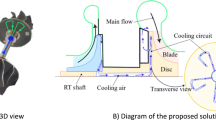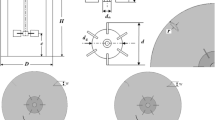Abstract
In view of the supercavitation effect, a novel device named the rotational supercavitating evaporator (RSCE) has been designed for the desalination. In order to improve the blade shape of the rotational cavitator in the RSCE for the performance optimization, the blade shapes of different sizes are designed by utilizing the improved calculation method for the blade shape and the validated empirical formulae based on previous two-dimensional numerical simulations, from which the optimized blade shape with the wedge angle of 45° and the design speed of 5 000 r/min is selected. The estimation method for the desalination performance parameters is developed to validate the feasibility of the utilization of the results obtained by the two-dimensional numerical simulations in the design of the three-dimensional blade shape. Three-dimensional numerical simulations are then conducted for the supercavitating flows around the rotational cavitator with the optimized blade shape at different rotational speeds to obtain the morphological characteristics of the rotational natural supercavitation. The results show that the profile of the supercavity tail is concaved toward the inside of the supercavity due to the re-entrant jet. The empirical formulae for estimating the supercavity size with consideration of the rotation are obtained by fitting the data, with the exponents different from those obtained by the previous two-dimensional numerical simulations. The influences of the rotation on the morphological characteristics are analyzed from the perspectives of the tip and hub vortices and the interaction between the supercavity tail and the blade. Further numerical simulation of the supercavitating flow around the rotational cavitator made up by the blades with exit edge of uniform thickness illustrate that the morphological characteristics are also affected by the blade shape.
Similar content being viewed by others
References
Likhachev D. S., Li F. C. Large–scale water desalination methods: a review and new perspectives [J]. Desalination and Water Treatment, 2013, 51(13–15): 2836–2849.
Likhachev D. S., Li F. C. Modeling of rotational supercavitating evaporator and the geometrical characteristics of supercavity within [J]. Science China–Physics, Mechanics and Astronomy, 2014, 57(3): 541–554.
Likhachev D. S., Li F. C., Kulagin V. A. Experimental study on the performance of a rotational supercavitating evaporator for desalination [J]. Science China–Technological Sciences, 2014, 57(11): 2115–2130.
Likhachev D. S. Study on the hydrodynamic characteristics of rotational supercavitating evaporator [D]. Doctoral Thesis, Harbin, China: Harbin Institute of Technology, 2013.
Rudenko B. How to make up water resources [J/OL], Journal of Science & Life, 2007, 12, Available from: www.nkj.ru/archive/articles/12366/ (in Russian).
González D., Amigo J., Suárez F. Membrane distillation: Perspectives for sustainable and improved desalination [J]. Renewable and Sustainable Energy Reviews, 2017, 80: 238–259.
Langenecker B., Zeilinger C. E. Method and apparatus for desalination of seawater [P]. U.S. Patent 7770830, 2010.
Langenecker B., Zeilinger C. E. Method for desalination of seawater [P]. U.S. Patent 8021557, 2011.
Crum L. A., Skinner M., Zeilinger S. A method for desalination and water remediation by hydrodynamic cavitation [C]. Proceedings of Meetings on Acoustics. Acoustical Society of America, Montreal, Canada, 2013, 19(1): 075028.
Zhang L., Dong H., Wang X. Temperature Response in the Process of Ultrasonic Seawater Desalination [C]. 2011 Asia–Pacific Power and Energy Engineering Conference (APPEEC), IEEE, Wuhan, China, 2011.
Hong L. Y., Gao M. Y., Zhang J. Y. et al. Research and design of ultrasonic device for seawater desalination [J]. Physics and Engineering, 2014, 24(2): 56–59(in Chinese).
Zheng Z. Y., Li F. C., Li Q. et al. Numerical study on the characteristics of natural supercavitation by planar symmetric wedge–shaped cavitators for rotational supercavitating evaporator [J]. Science China Technological Sciences, 2015, 58(6): 1072–1083.
Wagner W., Pruß A. The IAPWS formulation 1995 for the thermodynamic properties of ordinary water substance for general and scientific use [J]. Journal of Physical and Chemical Reference Data, 2002, 31(2): 387–535.
Franc J. P., Michel J. M. Fundamentals of cavitation [M]. New York, USA: Springer science & Business media, 2006, 111–118.
IAPWS. Release on the IAPW. Formulation 1995 for the Thermodynamic Properties of Ordinary Water Substance for General and Scientific Use [C]. Meeting of the International Association for the Properties of Water and Steam (IAPWS), Fredericia, Denmark, 1996.
IAPWS. Revise. Release on the IAPS Formulation 1985 for the Viscosity of Ordinary Water Substance[C]. Meeting of the International Association for the Properties of Water and Steam (IAPWS), Vejle, Denmark, 2003.
Schnerr G. H., Sauer J. Physical and numerical modeling of unsteady cavitation dynamics [C]. Fourth International Conference on Multiphase Flow, New Orleans, USA, 2001.
Lien F., Kalitzin G. Computations of transonic flow with the \(\overline{v^2}-f\) turbulence model [J]. International Journal of Heat and Fluid Flow, 2001, 22 (1): 53–61.
Senocak I., Shyy W. Interfacial dynamics–based modelling of turbulent cavitating flows, Part–1: Model development and steady–state computations [J]. International Journal for Numerical Methods in Fluids, 2004, 44: 975–995.
Zhang X. B., Qiu L. M., Qi H. et al. Modeling liquid hydrogen cavitating flow with the full cavitation model [J]. International Journal of Hydrogen Energy, 2008, 33(23): 7197–7206.
Brennen C. E. Cavitation and bubble dynamics [M]. New York, USA: Cambridge University Press, 2013, 227.
Author information
Authors and Affiliations
Corresponding author
Additional information
Project supported by the National Natural Science Foundation of China (Grant Nos. 51276046, 51576051, 51706050 and 51806051).
Biography: Zhi-ying Zheng (1988-), Male, Ph. D., Lecturer
Rights and permissions
About this article
Cite this article
Zheng, Zy., Li, Q., Wang, L. et al. Numerical study on morphological characteristics of rotational natural supercavitation by rotational supercavitating evaporator with optimized blade shape. J Hydrodyn 32, 468–485 (2020). https://doi.org/10.1007/s42241-019-0007-3
Received:
Revised:
Accepted:
Published:
Issue Date:
DOI: https://doi.org/10.1007/s42241-019-0007-3




